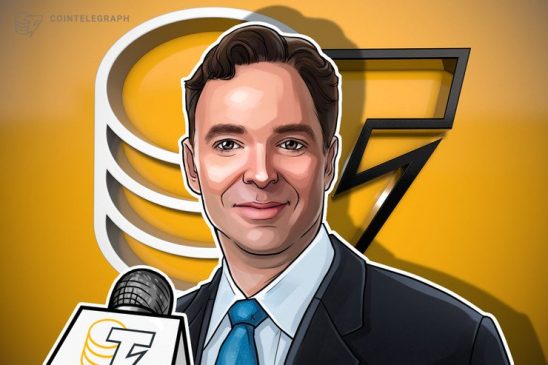In a varied career, Dan Schatt has been a Peace Corps volunteer in Romania, a Citibank banker in Senegal, a Celent analyst and a PayPal executive. He co-founded Cred, a decentralized lending and borrowing platform, with other PayPal technology veterans in 2018.
Cred attracted some attention last year when it enabled a California politician to purchase cannabis with Bitcoin Cash (BCH). The politician was the first elected official to use cryptocurrency to purchase cannabis in the United States, according to Cointelegraph, in a demonstration meant to show how blockchain and stablecoin technology could enable more effective tax collection.
Elsewhere, working with partners like Bitcoin.com, Uphold, Bitbuy and TrueUSD, Cred allows individuals to earn interest on their crypto holdings and also to borrow money using crypto as collateral.
Cointelegraph recently spoke with the Cred CEO about the power of blockchain, how it can expand the banking universe, the future of Bitcoin (BTC), tokenization and, yes, cannabis.
Tell us about the moment when you realized there had to be a better way to lend money.
When I served in the Peace Corps, I was posted in the wilds of Transylvania, and I saw these [business] people, individuals with good judgement, very intelligent, years of experience — but they were so far away from being able to access capital. The power of blockchain, the power of the internet, is that you can allow someone who would only be able to extend their reputation to their local village to extend it to the entire world.
They can suddenly become bankable?
Yes. Now, if I have access to the internet, I basically send in my passport information, ID and all of those things that are now possible to check in real-time to prove that I’m a legitimate guy — not a terrorist or money launderer.
Then, I can buy a little crypto, even $10–$20 worth. That crypto can then be used as collateral for a future loan. And the amazing thing about crypto: A Bitcoin is a Bitcoin is a Bitcoin anywhere in the world. Whether that person is in Senegal or Spain or Sri Lanka, we can take the Bitcoin, lock it down and give them liquidity.
By comparison, when I was a banker and moving around the world, I’d go to a local bank and open an account, and they’d always start me with a $500 credit line. And I’d say, “I had tens of thousands of dollars at my last bank,” and they’d say, “Sorry, you’re in this country now, you’re in our bank now. We’re starting you over.”
Now, as you pay back that crypto-based loan, you earn a reputation, and that reputation follows you even if you travel to another country. You can continue that borrowing relationship, and with time, that reputation can be expanded across the internet.
How long will it be before earning interest on the Bitcoin in your wallet becomes commonplace?
If your money is with a crypto custodian or with a crypto exchange, you can expect they will offer you an interest rate within the next two years. And you’re going to be able to collateralize [that deposited BTC] to borrow, too.
Cred is a decentralized lending platform. It takes deposits and makes loans. How does it differ from a traditional, centralized lending platform like a bank?
On any given day, we have hundreds of thousands, even millions, of dollars that will come in [i.e., deposits] from many countries in the world. But when the money comes in, the money doesn’t have to go from processor to bank, from processor to bank — it can go directly to the blockchain. If someone in another part of the world wants to pledge their Bitcoin, it can go from that customer to Cred and then be converted to dollars and even lent out — all within 15 minutes on a Friday night when the banking system is closed.
If you’re a bank that’s saddled with SWIFT [a standard for exchanging transaction information between financial institutions] and ACH [automated clearing house] and credit card networks and credit card processors, you can’t do that. You will always be saddled with that legacy infrastructure.
Are there other things that a decentralized lender and borrower can do that traditional banks can’t?
If I give you dollars today, and I say: “I’d like to have my interest payments in Bitcoin,” JPMorgan Chase could not do that. If I gave you Bitcoin, and I said I’d like my interest payment in dollars, a bank can’t do that. If I go to a merchant and I give that merchant a point of sale, and I say: “This can accept credit cards, but would you like us to settle with you in a stablecoin instead?” — banks can’t do that.
If you go to a traditional bank, you’ll be lucky if you get half a percent interest on your deposits. At Cred, half our deposits are from individual consumers who want a better deal, and they can earn up to an annual 10% interest on their Bitcoin.
Doesn’t Bitcoin’s price volatility make borrowing and lending against BTC inherently risky?
We’re a large consumer of Bitcoin futures. We’ve been buying them for a few years now. So, let’s say, you give us the Bitcoin when it is at $8,000. When you want your Bitcoin back, it’s at $24,000. We’ll give you your Bitcoin back and all the interest. We’re able to do that because we have lots of Bitcoin futures contracts that allow us to access Bitcoin at any price.
What are some of the key challenges facing the crypto industry today?
There’s a big problem with interoperability. Ethereum doesn’t talk to Bitcoin who doesn’t talk to EOS who doesn’t talk to XRP. If you really want people to develop with all these things, you need to develop interoperability.
There’s another challenge that I see in the industry with certain stablecoins like Tether because they are not substantiated one-to-one against the U.S. dollar. You can argue that one reason Libra caused so many concerns with U.S. regulators, who care a lot about U.S. dollars and seigniorage, was they looked at Libra’s token as a basket of different currencies, not just one.
You don’t think a stablecoin should be pegged to a basket of currencies?
I don’t think any major government wants to see its currency diluted in that way, being just a part of the many. The U.S. government gets a lot of value from the U.S. dollar being the world’s reserve currency, so if all of a sudden you hold another reserve currency [in a reserve basket], you don’t need as many dollars.
You’re part of a group of like-minded blockchain firms (Uphold, Bittrex International, Brave Software, Blockchain at Berkeley and CertiK) that have created a stablecoin.
The Universal Protocol Alliance built a reserve management infrastructure where you can deposit one digital asset and then we create an Ethereum-based token against that — one-to-one. So, if you stick in a dollar, you get back a Universal Dollar (UPUSD). And it’s all on-chain so you can see every time one is minted. That’s very powerful. And we’ve just produced a Universal Euro that is also one-to-one.
And this Universal Dollar is what Ohana Cannabis, a California dispensary, received when a local council member purchased marijuana with BCH?
Local politicians in California were thrilled when the state legalized recreational cannabis [in 2018] because the promise of tax revenue was enormous. What they soon learned, though, was that only 10 percent of their forecasts came to fruition. That’s because when you walk into a dispensary in California, the salesperson says, “Okay, that will be $102. Go over to that ATM machine, take out the cash and give it to me.” They process everything as cash. Needless to say, tax collectors don’t often collect sales tax on these types of transactions.
Hence the demonstration where Ben Bartlett paid with BCH by scanning the dispensary’s barcode with his Coinbase wallet mobile app.
The amazing thing is that these [tax collection] problems can be solved not with a change in behavior but by doing everything you normally do — whether swiping your credit card or your wallet app, in this case — and where everything eventually can be turned into stablecoins. Tax collectors can get their [UPUSD] payments in real-time.
What do you see for Bitcoin in the future?
I came to the conclusion in 2015 or so is that everything is going to be tokenized, every asset class will be digitized and then tokenized. Look at the $8-trillion market for gold. More gold today is held globally as an ETF (exchange-traded fund) than as a bar of gold.
We can now take monolithic, extensive assets and break them up and allow everyone to benefit. We got to six decimal points with stock. But with Bitcoin, you could go even further. A person in Ethiopia with access to the internet may one day be able to buy one cent worth of Apple stock.
And that’s how the Bitcoin market will go from $200 billion to $200 trillion because it’s going to envelop other existing asset classes as much as developing its own asset class.




